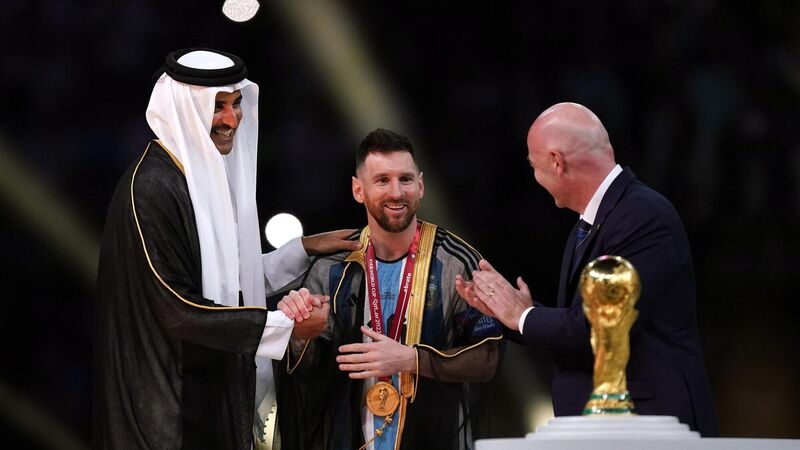Far from a 'shame', Lionel Messi's bisht moment was 'a mark of honour'

Emir of Qatar, Sheikh Tamim bin Hamad Al Thani dresses Argentina's Lionel Messi with traditional Arab bisht ahead of the trophy presentation.
WHEN The Emir, Sheikh Tamim placed a black and gold bisht – a traditional item of clothing worn in the region for special events and celebrations – on Lionel Messi before the Argentina legend was presented with the World Cup, most watchers did a double take.
Messi did not wear the attire for long, but long enough for some commentators to wonder had it spoiled the 35-year-old's moment of glory, and whether it was an act of propaganda by Qatari rulers.
“Seems a shame in a way that they’ve covered up Messi in his Argentina shirt,” said BBC host Gary Lineker.
“Something a little strange about Messi being dressed in Bisht, that black cloak that the emir of Qatar dressed him in before lifting the World Cup,” New York Times journalist Tariq Panja tweeted. “Qatar wants this to be its moment as much as it is Messi’s and Argentina’s.”
The Telegraph called it “the bizarre act that ruined the greatest moment in World Cup history” before later toning it down to “Lionel Messi made to wear traditional Arab bisht for World Cup trophy lift.”
Dr Mustafa Baig, a lecturer in Islamic Studies at the University of Exeter, explained Monday that the bisht is a formal robe worn by royalty, dignitaries, grooms on their wedding day, and graduates at graduation ceremonies.
"So only a select few people would actually wear the bisht," he said. "They basically honoured him by putting it over his shoulders. It's like a mark of honour, and just kind of a cultural welcoming and a cultural acceptance."
Dr Baig said it is also representative of Qatar's national dress - but only at important occasions.
"And this is a top occasion. I mean, there's probably no bigger occasion, so they put it on him as a mark of honour," he said.
Dr Baig said he saw it as "an embrace by Messi of the local culture", adding that it was "a pretty cool thing" for Qatar to do and "smart thinking" on their behalf.
Hassan Al Thawadi, Secretary General of the Qatar’s Supreme Committee for Delivery & Legacy (SC), an organisation charged with organisng the World Cup, explained: “It is a dress for an official occasion and worn for celebrations. This was a celebration of Messi,” Al Thawadi told BBC Sport. “The World Cup had the opportunity to showcase to the world our Arab and Muslim culture. This was not about Qatar, it was a regional celebration.
“People from different walks of life were able to come, experience what was happening here and get to understand that we may not see eye to eye on everything, but we can still celebrate together.” ‘Preconceived notions’
“Some are mad because Messi wore a bisht (it was gifted to him; a symbol of appreciation and respect in the Arab culture),” writer and columnist Reem Al-Harmi tweeted. “However, I didn’t see the same level of anger and outrage when racism, Islamophobia, and orientalism was constantly used against the World Cup in Qatar.
“Instead of preconceived notions & judgmental views, turning this beautiful and meaningful photo into something that is not, read about the Arab bisht; its importance, and why/when it’s worn.
“Gifting someone a bisht, shows how significant/respectful they are, that’s Messi today.”













